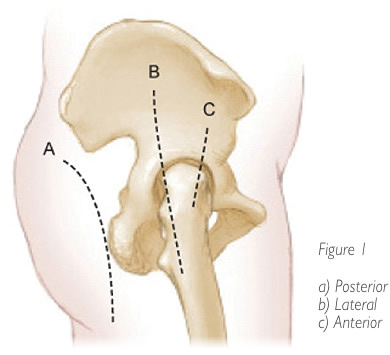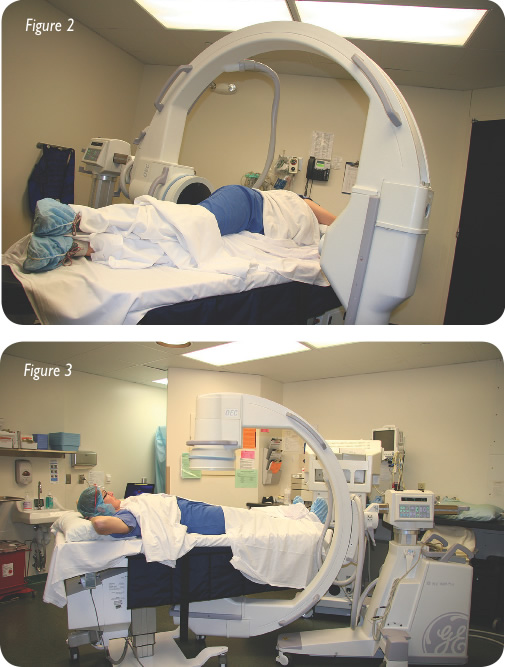Direct Anterior
Hip Replacement
Nathaniel Stewart, MD
Orthopedic Surgery
Chippewa Valley Orthopedics & Sports Medicine Altoona
 Direct anterior hip replacement is an increasingly popular technique of replacing a worn out hip. When replacing a hip, there are several options available to the surgeon and patient. These include the implant, the approach (or technique to reach the hip joint), and the method of checking the implant position during the operation. The direct anterior hip replacement is a specific approach, or method of getting down to the hip joint, which has several advantages as compared to other commonly used methods. The approach determines the structures that need to be pulled out of the way, or cut, in order to reach the hip. These structures need to heal after surgery, and so the approach effects how quickly the hip recovers after an operation. Until recently, most surgeons approached the hip from the posterior or lateral direction (see Figure 1a and 1b). Both of these approaches involve some degree of muscle cutting, the lateral approach more so than the posterior approach. The direct anterior approach requires no muscle cutting. There is also less muscle retraction, or pulling, than either of more traditional approaches (Figure 1c). This allows for faster recovery of function.
Direct anterior hip replacement is an increasingly popular technique of replacing a worn out hip. When replacing a hip, there are several options available to the surgeon and patient. These include the implant, the approach (or technique to reach the hip joint), and the method of checking the implant position during the operation. The direct anterior hip replacement is a specific approach, or method of getting down to the hip joint, which has several advantages as compared to other commonly used methods. The approach determines the structures that need to be pulled out of the way, or cut, in order to reach the hip. These structures need to heal after surgery, and so the approach effects how quickly the hip recovers after an operation. Until recently, most surgeons approached the hip from the posterior or lateral direction (see Figure 1a and 1b). Both of these approaches involve some degree of muscle cutting, the lateral approach more so than the posterior approach. The direct anterior approach requires no muscle cutting. There is also less muscle retraction, or pulling, than either of more traditional approaches (Figure 1c). This allows for faster recovery of function.
The approach taken can also influence the patient’s chances of having a dislocation, which is an uncommon, but potentially serious complication. To avoid dislocation, patients with more traditional approaches typically are asked to avoid certain positions for the first three months after surgery. The risk of dislocations is considerably lower with the direct anterior approach, so much so, that patients are given few, if any, post-operative restrictions. This allows the direct anterior patient more immediate flexibility in their activities of daily living.
 The approach can also influence the ease with which the surgeon may check the position of the components after they have been inserted. The methods used to check component position include x-ray, computer navigation, and robotic assistance. X-ray is perhaps the most direct and reliable, as evidenced by the fact that surgeons using computer navigation and the robot still double check component position with an x-ray. For traditional approaches to the hip, the patient is on their side with the hip facing up, a difficult position from which to get a well-aligned x-ray (Figure 2).
The approach can also influence the ease with which the surgeon may check the position of the components after they have been inserted. The methods used to check component position include x-ray, computer navigation, and robotic assistance. X-ray is perhaps the most direct and reliable, as evidenced by the fact that surgeons using computer navigation and the robot still double check component position with an x-ray. For traditional approaches to the hip, the patient is on their side with the hip facing up, a difficult position from which to get a well-aligned x-ray (Figure 2).
For the direct anterior hip, patients lay flat on their back, a reproducible position from which it is easier to get an accurate x-ray. (Figure 3) Only an accurate x-ray can ensure accurate component position.
With these advantages, why were the more traditional approaches popular initially? It’s not like we just discovered the front of the hip. The main reason for the surging popularity of direct anterior hip replacement is that new tables allow us to control the operative leg while doing direct anterior hip replacement. Prior to this, when performing direct anterior hip replacement the leg dangled off the side of the bed, an unstable and awkward position. The new tables make the direct approach easier and more reliable.
In conclusion, the direct anterior hip replacement offers faster recovery, less risk of dislocation, and ease of checking component position with an x-ray during surgery. While there are other considerations in hip replacement surgery, the direct anterior approach offers advantages that many patients may be interested in pursuing.
Dr. Stewart – Chippewa Valley Orthopedics & Sports Medicine
For information or to schedule an appointment:
715-832-1400 | 800-322-1747 | www.cvosm.com
Dr. Stewart sees patients in Altoona, Chippewa Falls and Ladysmith.




 Direct anterior hip replacement is an increasingly popular technique of replacing a worn out hip. When replacing a hip, there are several options available to the surgeon and patient. These include the implant, the approach (or technique to reach the hip joint), and the method of checking the implant position during the operation. The direct anterior hip replacement is a specific approach, or method of getting down to the hip joint, which has several advantages as compared to other commonly used methods. The approach determines the structures that need to be pulled out of the way, or cut, in order to reach the hip. These structures need to heal after surgery, and so the approach effects how quickly the hip recovers after an operation. Until recently, most surgeons approached the hip from the posterior or lateral direction (see Figure 1a and 1b). Both of these approaches involve some degree of muscle cutting, the lateral approach more so than the posterior approach. The direct anterior approach requires no muscle cutting. There is also less muscle retraction, or pulling, than either of more traditional approaches (Figure 1c). This allows for faster recovery of function.
Direct anterior hip replacement is an increasingly popular technique of replacing a worn out hip. When replacing a hip, there are several options available to the surgeon and patient. These include the implant, the approach (or technique to reach the hip joint), and the method of checking the implant position during the operation. The direct anterior hip replacement is a specific approach, or method of getting down to the hip joint, which has several advantages as compared to other commonly used methods. The approach determines the structures that need to be pulled out of the way, or cut, in order to reach the hip. These structures need to heal after surgery, and so the approach effects how quickly the hip recovers after an operation. Until recently, most surgeons approached the hip from the posterior or lateral direction (see Figure 1a and 1b). Both of these approaches involve some degree of muscle cutting, the lateral approach more so than the posterior approach. The direct anterior approach requires no muscle cutting. There is also less muscle retraction, or pulling, than either of more traditional approaches (Figure 1c). This allows for faster recovery of function. The approach can also influence the ease with which the surgeon may check the position of the components after they have been inserted. The methods used to check component position include x-ray, computer navigation, and robotic assistance. X-ray is perhaps the most direct and reliable, as evidenced by the fact that surgeons using computer navigation and the robot still double check component position with an x-ray. For traditional approaches to the hip, the patient is on their side with the hip facing up, a difficult position from which to get a well-aligned x-ray (Figure 2).
The approach can also influence the ease with which the surgeon may check the position of the components after they have been inserted. The methods used to check component position include x-ray, computer navigation, and robotic assistance. X-ray is perhaps the most direct and reliable, as evidenced by the fact that surgeons using computer navigation and the robot still double check component position with an x-ray. For traditional approaches to the hip, the patient is on their side with the hip facing up, a difficult position from which to get a well-aligned x-ray (Figure 2).